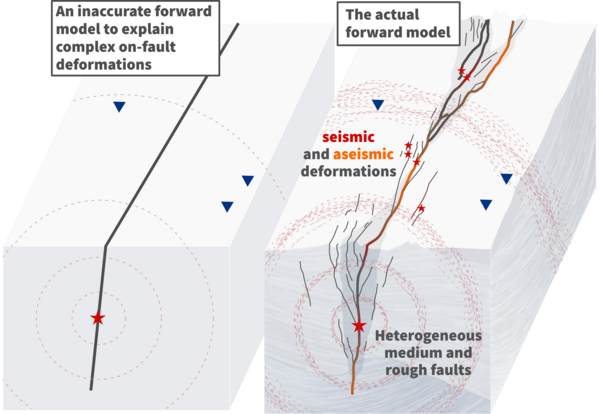Deformation on faults is complex and mildly understood beyond first order characteristics, one reason being the uncertainty of inferred finite-fault models. Inversion methods aim at estimating an unknown earthquake source or slip from indirect measurements at the Earth’s surface by assuming that the source and measurements are related via a known forward model, or Green’s functions. Yet, the forward model is often inaccurate and ignores complexities that are either hard to capture or simply unknown. In this talk, we will use some examples to explore how, and in which cases, non-realistic assumptions in the forward model can bias estimates of co-, post- and inter-seismic deformations and need to be accounted for. Such inaccuracies include neglecting variations in elastic properties, topography, and visco-elasto-plastic deformations. With each example, we will discuss how we can overcome our poor knowledge of the forward problem and what are the remaining open issues.
This exploration will start with a study of the secondary zone of surface uplift (SZU) that has been measured after several megathrust earthquakes at ~300 km from the trench. The SZU peaked at 12 cm less than a day after the 2010 Mw 8.8 Maule (Chile) earthquake, and none of the published coseismic finite-fault models do reproduce the measured uplift. While the SZU could be caused by volume deformation around the slab, we show it can also be explained by early afterslip, but only if variations in elastic properties are accounted for.
Subduction zone toy models will then help us in exploring how inaccuracies in the forward models trade-off with data distributions and slip locations to affect our understanding of on-fault co-seismic slip, and how slip inference can be improved. In particular, I will show with a probabilistic approach that accuracy of near-trench slip estimates can be increased by >50% if incorporating uncertainties in the forward problem. A brief detour to inversion of interseismic coupling will be the occasion to discuss if we need to go beyond the commonly used assumption of fully-elastic interseismic displacements.
To account for complexities in crustal properties, a common approach in kinematic modeling of the seismic source is to use, directly or by deconvolution, small collocated events as empirical Green’s functions. But these approaches usually neglect uncertainties in the forward model. I will finally present some preliminary results on the stochastic deconvolution of empirical Green’s functions that allow us to estimate these uncertainties, by jointly solving for the most probable empirical Green’s functions and moment rate function.


